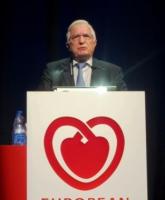Unstable angina died last week, at the European Society of Cardiology’s annual Congress in Munich.
The term "unstable angina" was 41 years old, and is survived by its close sibling, non–ST-segment elevation myocardial infarction (NSTEMI). The cause of death was increasing reliance on high-sensitivity (hs) cardiac troponin assays and the Third Universal Definition of MI that was released last week, and was in part designed to address the shifting acute coronary syndrome landscape created by hs cardiac troponin assays.
Cardiologists first coined unstable angina in 1971 and, in the years following, applied it to hundreds of thousands of patients annually, patients with chest pain caused by acute, ischemic cardiac episodes that failed to produce the electrocardiogram change – an ST-segment elevation – that is the hallmark of a full-blown myocardial infarction.
Over time, increased sophistication in the ability of cardiologists to discern cardiac pathology led to the term NSTEMI; as recently as last year, official cardiology diagnostic guidelines considered unstable angina and NSTEMI virtual twins. The distinction was that NSTEMI produced a measurable, pathognomonic rise in serum levels of cardiac troponin or other serum markers of cardiac damage, with no such rise discernable in unstable angina patients.
The Third Universal Definition changed that. As explained by Professor Freek Verheugt, a Dutch cardiologist who commented on the implications of the new definition last week at the ESC meeting, the new definition’s official adoption of hs cardiac troponin levels as the gold standard for myocardial infarction diagnosis left unstable angina in limbo. It had "disappeared," he said.
"If hs troponins are completely neutral in a patient with chest pain, it’s impossible that the patient has significant coronary disease," he explained to me in an interview. "They therefore have some other condition causing the chest pain. Troponin tests are so sensitive now that they exclude a cardiac cause" when no rise occurs.
In other words, patients with acute chest pain, no ST-segment elevation, and a discernable rise in hs cardiac troponin have NSTEMI. Patients with acute chest pain, no ST-segment elevation, and no rise in their hs cardiac troponin level must have a noncardiac cause for their pain.
Unstable angina, R.I.P.
–Mitchel Zoler (on Twitter @mitchelzoler)
